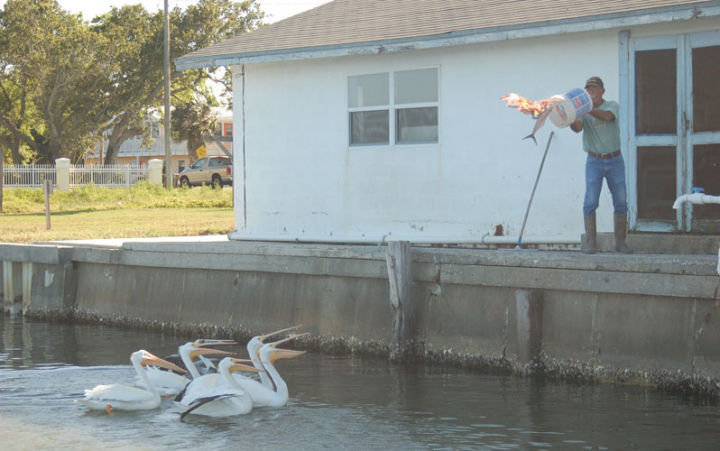
SEBASTIAN — A cloud of stark white plumes races toward the seawall when the sound of the old screen door screeching open drifts across the water. It can mean only one thing: feeding time for the American White Pelicans at Judah and Son Fish Market along the Indian River Lagoon.
The seven white pelicans that have not yet headed north sit all day along the boardwalk or float on lapping waters, waiting for hours for that signal – the creek of the door – to call them toward the fish house, a remainder of what was once a prolific commercial fishing industry along the Indian River Lagoon in Sebastian.
The other 100-plus American White Pelicans that call outside the fish house home during the winter have already headed north, convinced that spring has indeed sprung.
The downy birds of magnificent size – the longest in North America measuring between 50 to 70 inches thanks to the elongated bill – have been the subject of many a photograph, sketch and of even plume hunters in 1800s when nearby Pelican Island became a slaughter house until a German immigrant began standing guard on the island.
That immigrant eventually persuaded Teddy Roosevelt to protect the island and its magnificent creatures including the American White Pelicans.
American White Pelicans primarily spend their winters along the Pacific and Gulf coasts, though for decades a large number has of them have come to Judah and Son Fish Market.
“They are looking for a hand-out,” said James Bobby Judah, who manages the circa 1940s fish market.
The birds roost for the night on a nearby spoil island just south of the fish market. Come daybreak, they head to the Judah’s dock waiting for some fish parts and chum when the doors open around 7:30 a.m.
The American White Pelicans begin arriving in the fall and by the start of winter their numbers are well into the hundreds, Judah said.
And white pelicans mean business for Judah.
“We’re the biggest tourist attraction on this side of Disney,” Judah said. “It’s really unbelievable all the people that come out here to take picture of the pelicans.”
Judah keeps a five-gallon bucket near his cutting table. The scraps from the day’s catch will go to feed the pelicans.
He’s been known in the winter to fill the bucket, five, sometimes as many as seven times in one day, to feed his winter friends.
“They are lazy now,” says Judah. “They don’t want to fish for themselves anymore. They want me to do it.”
In less than an hour’s time last week, the pelicans were given another bucket of chum, this time from fisherman Sheldon Deal.
“They’ll eat anything,” he said.
Deal said it’s easy to tell if the pelicans have had a good day of feeding: they fly back to the spoil island for the night. Without a hearty day of eating, they reserve their energy and paddle back to the island.
Deal who has fished much of the local waters said he has never seen a white pelican much further south of St. Lucie County.
“They are something,” he says.
A woman who stopped by the market agreed.
“Oh look at the pretty swans,” she said as she stepped outside the old creaky door.
Deal corrects the woman and she laughs off what is somewhat of a common mistake because the bird’s sheer size and relative obscurity in nature.
American White Pelicans rival the trumpet swan in size but have the second largest wing span of all North American birds – the California condor has the largest.
Like the swan of Hans Christian Andersen’s classic tale of the ugly duckling, young American White Pelicans start life a dull grey with brownish patches and mature into their gleaming white plumage.
Neither Deal nor Judah knows for sure where these birds spend the non-winter months. Bird enthusiasts from across the state in Punta Gorda claim to know that their winter white pelicans come from the Grand Tetons.
The pelicans are said to make their journey south for the winter without stopping. After the winter, or typically in February, they head back with nesting on their mind. They don’t dive bomb for food like the brown pelican and prefer brackish and fresh water.
They nest in colonies of several hundred pairs throughout central Canada and northern Midwest states. The furthest south they have been known to nest and spend all but their winter months is in southern Wyoming.
There are several historic photos of the beautiful snowy with creatures on Pelican Island on display at the Sebastian Historical Society Museum.
More than 100 years ago, Pelican Island became the nation’s first land refuge for birds.
“Protecting the pelicans from the plume hunters was an amazing period of history for our area,” according to the Sebastian Area Historical Society book, “Even More Tales of Sebastian.”
Dot Judah, co-owner of Judah and Son Fish Market, shot the two-page photograph of white pelicans at the start of the book outside her fish house.
“Oh, the pelicans outside the fish market are just getting so fat because Bobby feeds them all,” Dot Judah said with a laugh. “But we all just love seeing them in the winter.”



